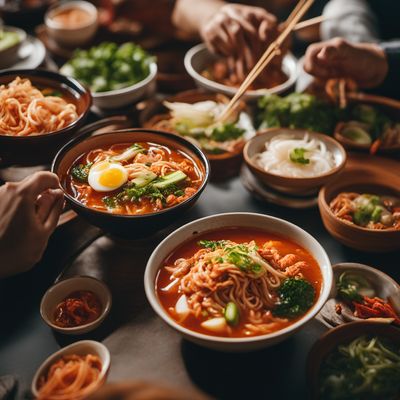
Recipe
Tajik Janchi Guksu
Silk Road Noodle Delight
4.5 out of 5
Indulge in the flavors of Tajik cuisine with this delightful twist on the classic Korean dish, Janchi Guksu. Tajik Janchi Guksu combines the comforting warmth of a noodle soup with aromatic spices and herbs, creating a unique and satisfying culinary experience.
Metadata
Preparation time
20 minutes
Cooking time
15 minutes
Total time
35 minutes
Yields
4 servings
Preparation difficulty
Easy
Suitable for
Vegetarian, Vegan, Dairy-free, Nut-free, Gluten-free (if using gluten-free noodles)
Allergens
N/A
Not suitable for
Paleo, Keto, Low-carb, High-protein, Atkins
Ingredients
Tajik Janchi Guksu differs from the original Korean dish in terms of spices and herbs used. While the Korean version relies on flavors like soy sauce and sesame oil, the Tajik adaptation incorporates spices such as cumin, coriander, and turmeric. Additionally, the use of dill and cilantro as fresh herbs adds a distinct Tajik touch to the dish. We alse have the original recipe for Janchi guksu, so you can check it out.
-
250g (8.8 oz) handmade noodles 250g (8.8 oz) handmade noodles
-
1 liter (4 cups) vegetable broth 1 liter (4 cups) vegetable broth
-
1 onion, finely chopped 1 onion, finely chopped
-
2 cloves of garlic, minced 2 cloves of garlic, minced
-
1 teaspoon ground cumin 1 teaspoon ground cumin
-
1 teaspoon ground coriander 1 teaspoon ground coriander
-
1/2 teaspoon ground turmeric 1/2 teaspoon ground turmeric
-
1 carrot, thinly sliced 1 carrot, thinly sliced
-
1 bell pepper, thinly sliced 1 bell pepper, thinly sliced
-
Fresh dill, for garnish Fresh dill, for garnish
-
Fresh cilantro, for garnish Fresh cilantro, for garnish
-
Salt, to taste Salt, to taste
-
Black pepper, to taste Black pepper, to taste
Nutrition
- Calories (kcal / KJ): 250 kcal / 1046 KJ
- Fat (total, saturated): 2g, 0g
- Carbohydrates (total, sugars): 50g, 5g
- Protein: 8g
- Fiber: 5g
- Salt: 2g
Preparation
-
1.In a large pot, heat some oil over medium heat. Add the chopped onion and minced garlic, and sauté until they turn golden brown.
-
2.Add the ground cumin, ground coriander, and ground turmeric to the pot. Stir well to coat the onions and garlic with the spices.
-
3.Pour the vegetable broth into the pot and bring it to a boil.
-
4.Add the handmade noodles to the boiling broth and cook them according to the package instructions or until they are al dente.
-
5.Once the noodles are cooked, add the thinly sliced carrot and bell pepper to the pot. Cook for an additional 2-3 minutes until the vegetables are tender.
-
6.Season the soup with salt and black pepper to taste.
-
7.Remove the pot from heat and garnish the soup with fresh dill and cilantro.
-
8.Serve Tajik Janchi Guksu hot and enjoy!
Treat your ingredients with care...
- Handmade noodles — If you can't find handmade noodles, you can substitute with store-bought wheat or rice noodles. Adjust the cooking time accordingly.
Tips & Tricks
- For a spicier kick, add a pinch of chili flakes or a dash of hot sauce to the soup.
- Customize the vegetable toppings based on your preference. You can add mushrooms, snow peas, or any other vegetables you enjoy.
- To enhance the flavor, you can add a splash of soy sauce or a squeeze of lemon juice before serving.
- If you prefer a thicker broth, you can dissolve a tablespoon of cornstarch in water and add it to the soup during the last few minutes of cooking.
- Leftovers can be stored in the refrigerator for up to 3 days. Reheat gently on the stovetop or in the microwave before serving.
Serving advice
Serve Tajik Janchi Guksu in individual bowls, making sure to distribute the noodles, vegetables, and broth evenly. Garnish each bowl with a generous amount of fresh dill and cilantro for added freshness and aroma. Serve with a side of warm bread or naan to complete the meal.
Presentation advice
To present Tajik Janchi Guksu beautifully, arrange the colorful vegetables on top of the noodles in an appealing manner. Sprinkle some additional fresh herbs on top for an extra pop of green. Serve the soup in elegant bowls or traditional Tajik ceramic bowls to showcase the cultural influence.
More recipes...
For Korean cuisine » Browse all
More Korean cuisine dishes » Browse all

Jeyuk bokkeum
Stir Fried Spicy Pork
Jeyuk bokkeum is a traditional Korean dish that is made with pork and vegetables. The dish is popular all over Korea and is often served as a main course.

Miyeokguk
Seaweed soup
Miyeokguk is a traditional Korean soup made with seaweed and beef broth. It is often served on birthdays and after giving birth as it is believed...

Kimchi-guksu
Spicy kimchi noodle soup
Kimchi-guksu is a Korean noodle soup made with kimchi and wheat noodles. It is a popular dish in Korea, especially during the summer months.










